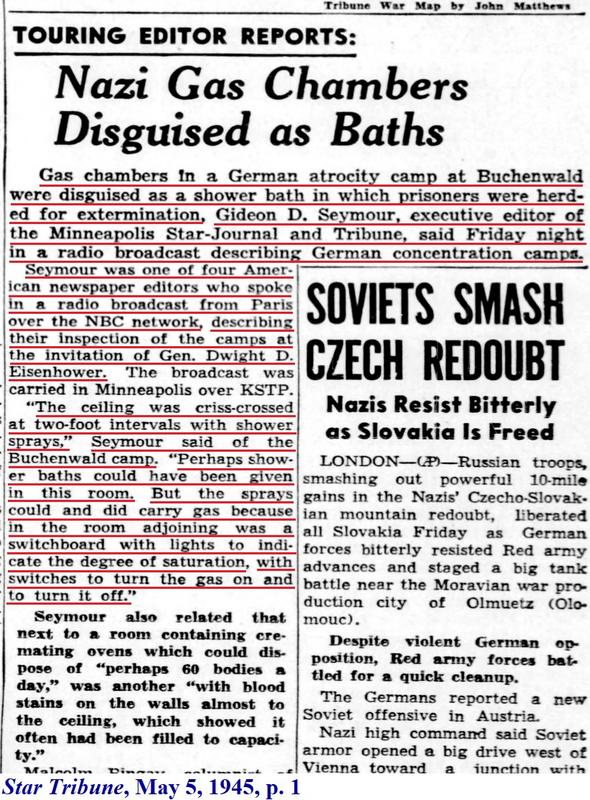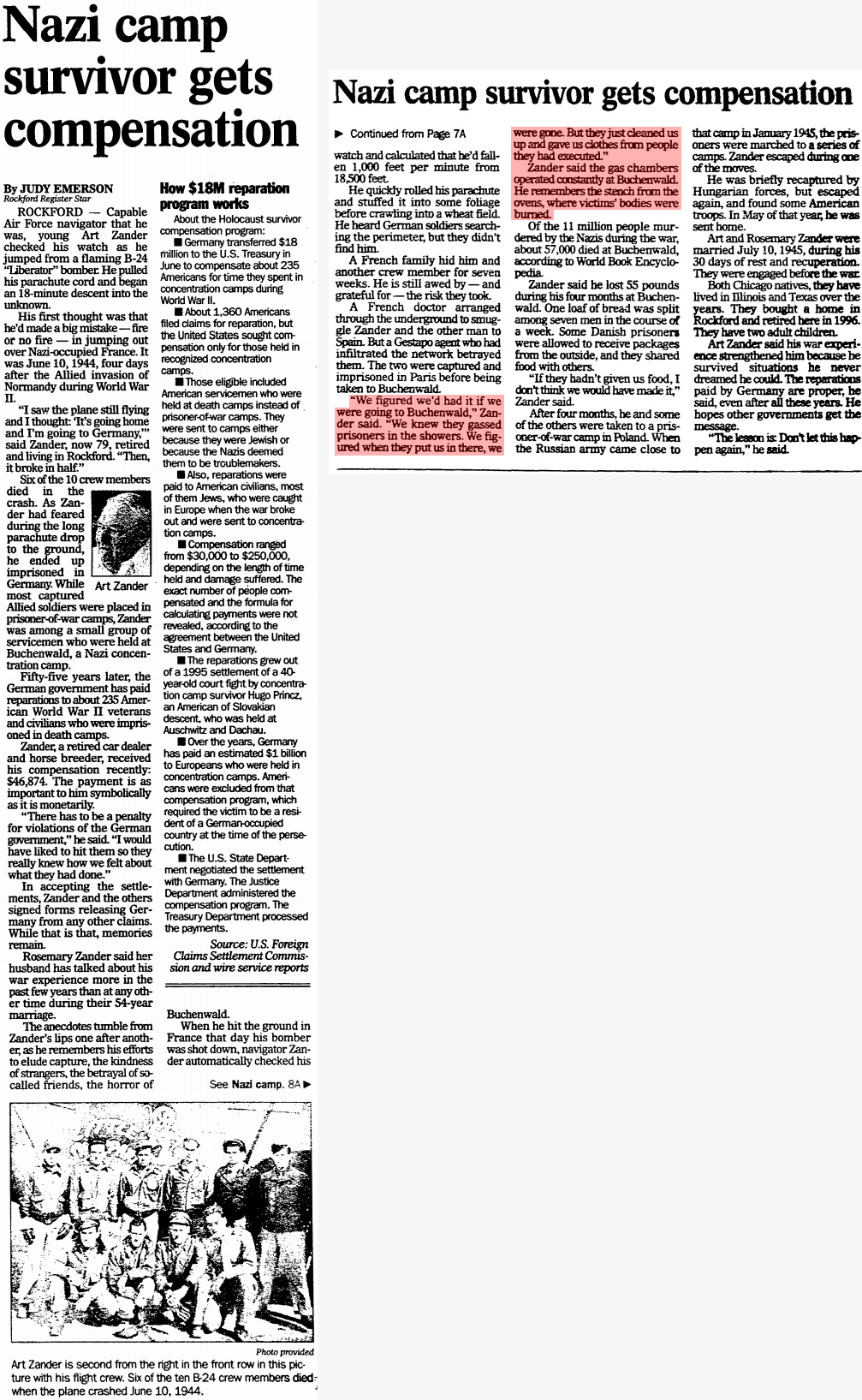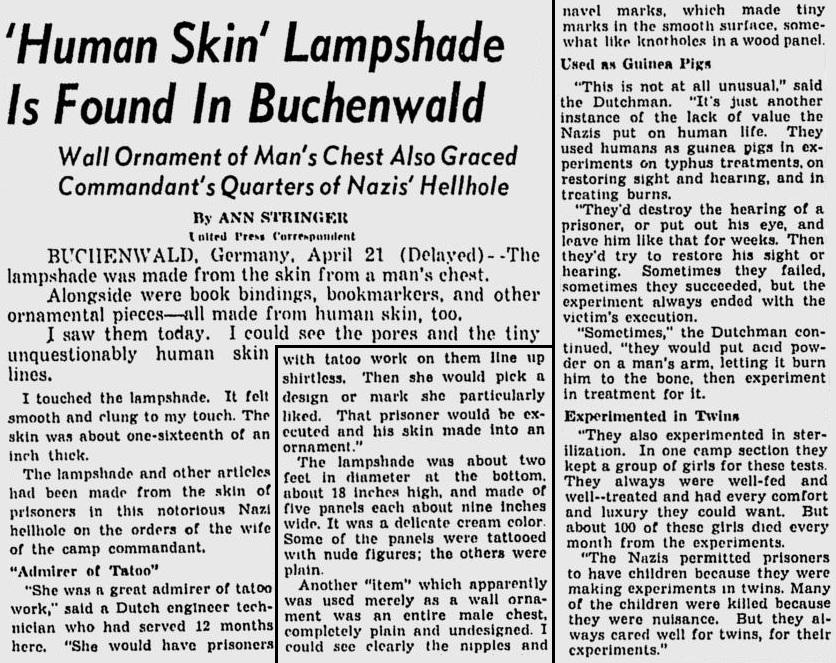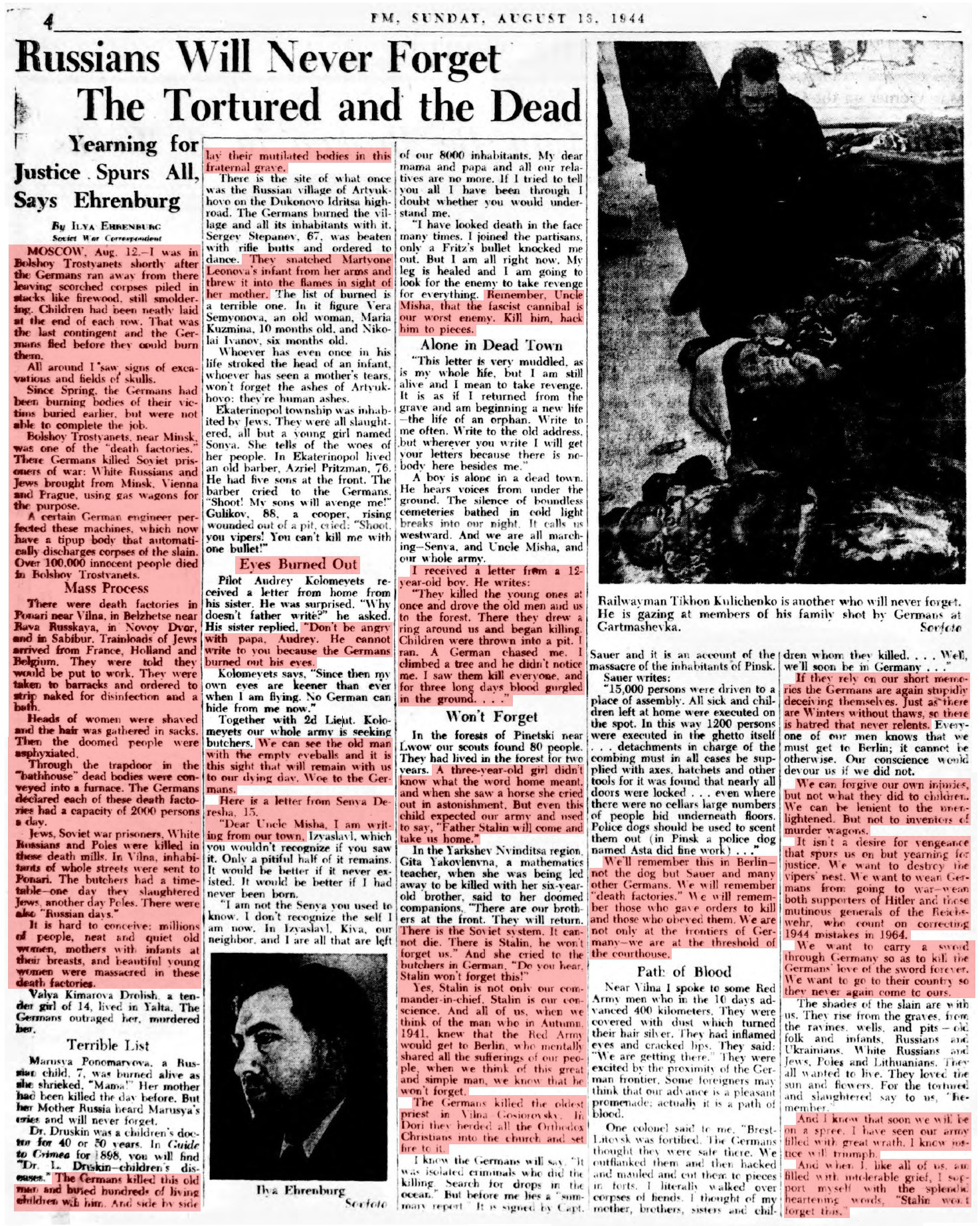Lamprecht wrote:Various testimonies claiming "Gas chambers" at Buchenwald:
Buchenwald gas chamber?
https://archive.is/ZGCiw
....
Eugen Kogon didn't claim gas chambers in Buchenwald saying that only a number of camps had them. He uses other testimony with physical impossibilities:
Initially the SS had used a killing machine, but this was superseded when it did not work fast enough, It operated as follows: there was a raised wooden platform, with a vertical beam, ostensibly for measuring body height. The beam, however, concealed a truncheon suspended at shoulder height. When the victim stepped on the platform the truncheon was tripped, smashing the skull or breaking the
neck.
This machine did not always kill. Those who were merely injured were nevertheless carted off to the crematory, where the coup de grace was administered with a big oaken club, Zbigniev Fuks, an assistant in the crematory, had the harrowing experience of having a Russian prisoner of war, brought in with a batch of bodies, actually address him: "‘Give me your hand, friend!” He had been lying, naked and bloody, atop a whole heap of corpses. SS Technical Sergeant Warnstedt, chief of the Buchenwald Crematory, instantly leaped up and killed the man with a shot from his gun.
When the execution shipments grew too large, the prisoners had to strip in the open air outside the stable. They were then lined up in big batches in the riding hall and mowed down with a machine-gun. Sawdust was sprinkled over the blood and the next batch admitted. Unlimited quantities of liquor were available for the killers.
The victims were not always ignorant of the fate awaiting them. On occasion one of the naked men would try to escape and run through the guard line drawn up around the area. In one such case the Ukrainian SS man refused to shoot* Henceforth only German SS men were employed as guards.
Civilians too were liquidated in the stable. One day a bus from the Apolda Transportation Company arrived, bearing a number of well-dressed Germans and a few officers. This was about four o’clock in the afternoon. The arrivals entered the stable, engaged in animated conversation. As soon as they were inside, a guard line drew up* Two hours later the crematory received a new batch of bodies.
The entire SS crew of “ Detail 99” was decorated with the War Merit Cross*
Only a very few camps had gas chambers of their own. But there were mobile gas chambers, vans that somewhat resembled the closed "'Black Marias'" of the police, for emergency use in exterminating prisoners. Gassing in these cars seems to have been slow, since they usually drove about a good deal before they stopped to discharge the corpses.
At Auschwitz, however, there was a huge gas plant—actually at Birkenau, a part of Auschwitz—which embraced five crematories together with four gas bunkers built into the ground. Each of these had an average capacity of twelve to fifteen hundred persons. The fifth crematory had no furnaces. It was only a huge fire pit.
In all the eastern camps and ghettos, designation for death in the gas chamber was known as ‘‘selection**—understandably a term that came to spread panic. In Auschwitz proper the “selectees” were assigned to special barracks, where they were kept under sharp guard. They often remained in isolation for two or three days, generally without food, for they were already considered “scratched.” At the Auschwitz hospital patients of all kinds were never permitted to exceed ten per cent of the camp strength, Any excess numbers were automatically sent to the gas chambers. The personnel servicing this plant numbered about one thousand prisoners, all of them Jews. The victims were lined up before the pit naked and shot down by the SS, the bodies—or the wounded! —toppling directly into fire. The Camp Commandant, SS Captain Kramer, never missed these mass executions. He generally stood by beaming, slapping his thighs with glee when the scene grew especially exciting, Not all the prisoners were what came to be knowm as “Moslems,” men who were physically and mentally broken, who allowed anything to be done to them. There were prisoners who went on their death march with militant songs on their lips, shouting to the SS, “We today, you tomorrow!” As for those who were neither apathetic nor militant, no one will ever know what went on in their minds.
The gas chambers were simplicity itself, yet they were planned with diabolical ingenuity. Each chamber had the appearance of a public bath, and was so represented to the victims. In the dressing-rooms there were signs, in all the principal languages of Europe, instructing the prisoners to lie their shoes together and fold their clothes neatly to avoid loss.
Hot coffee was promised after the bath, From the dressing rooms the way led directly to the “bath,” where hydrocyanic acid gas was admitted through the shower heads and ventilator outlets as soon as the doors had been dosed. Death took as long as four or five minutes, depending on the amount of gas available* During this time the most dreadful screams could be heard from the men, women and children inside, as their lungs slowly ruptured. Any bodies that showed signs of life when the doors had been opened were clubbed into
quiescence. The prisoners of the service squad then dragged out the bodies, stripped off any rings, and cut off the hair,
which was bundled into sacks and shipped to plants for processing. (In 1944 a young Jew from Brno, Yanda Weiss, was a member of this squad, He is the source of the details here presented, which have been confirmed from other sources.)
The bodies were then stacked in piles of ten each* SS Technical Sergeant Moll, in charge of the Auschwitz crematories, made his tour of inspection, after which the bodies were thrown into the furnaces or the fire pit, Moll was fond of placing naked women against the edge of the fire pit and watching them fall into the flames when they were shot in the abdomen. On one occasion he found a prisoner from the
service squad in possession of a ring. He had the man drenched with gasoline and then set afire. Another man he suspended by the hands, shooting at him until the arm parted. He then repeated the process with the man's feet.
On another occasion Roll Call Officer Schillinger made an Italian dancer perform naked before the crematory. Taking advantage of a favorable moment, the woman approached him, siezed his gun, and shot him down* In the ensuing struggle she herself was killed, at least escaping death by gas.
Early in 1945 Auschwitz was evacuated and the gas chambers blown up. Some of the SS fiends who had done this work were transferred to Buchenwald, where they went about boasting of their foul deeds. They were plentifully supplied with valuables. They kept reminiscing about the “wild life’' at Auschwitz, with its “strong medicine and constant alcoholic indulgences/'
The chief victims of Auschwitz were Jews from all the countries of Europe that had come under Hitler's rule. But there were also Poles, Russians, aged and decrepit prisoners of other nationalities, and a contingent of the sick. The highest “output" attained by Auschwitz was 34,000 bodies, in one continuous day and night shift. According to the confession of Camp Commandant Hoss, during his reign alone, from 1942 to early 1944, some 2,500,000 persons were gassed at Auschwitz.
https://archive.org/details/EugenKogonT ... ll/page/n2
Kogon was quite frank about for whom he told the stories:
On April 16, 1945, five days after the first American armored units had arrived, an Intelligence Team from the Psychological Warfare Division visited the Buchenwald concentration camp. Its mission w'as to study the situation and to prepare a comprehensive report for Supreme Headquarters, Allied Expeditionary Forces (SHAEF), The report was to show how a German concentration camp was organized, what role was assigned to it in the Nazi State and what happened to those who were sent to the camps by the Gestapo and detained there by the SS.
...Under the direction of Lieutenant Albert G. Rosenberg, the members of the team. Max M, Kimcntal, Richard Akselrad, Alfred H. Sampson and Ernest S, Biberfeld, began to lay the groundwork for an objective and conclusive report. Their own work in helping to dissolve the camp quickly made them realize that it was quite impossible for outsiders to gain even an approximately accurate picture of the complex situation within the camp and to evaluate its true significance. Such a task could be carried out only in close collaboration with a few reliable camp inmates who had no axe to grind. Kogon was asked to take over this job.
The initial report was completed in Weimar within about a month. Constant liaison was maintained with the camp and the numerous groups of former prisoners, and rather formidable difficulties had to be overcome, as will become evident from many of the chapters in this book. The first report comprised some 400 typewritten pages, single-spaced. There was a main report of 125 pages which Kogon himself had dictated, and approximately 150 statements from individual prisoners who* by virtue of their experience, had been asked to give their view's on various facts, incidents, persons and phases. Kogon's chief collaborators were the Socialist writer Ferdinand Romhild; Heinz Baumeister of Dortmund, a Social Democrat; and Stefan Heymann, an orthodox Communist editor with whom Kogon was on excellent terms, although Heymann had been detailed by the Communist leadership in camp to serve as a check on him,
Kogon consulted further with Dr. Werner Hilpert, former leader of the Catholic Action in Saxony and chairman of the Catholic Center party in Saxony, as well as with The radical leftist writer Franz Hackct. Except for Stefan Heymann, Kogon had long been on terms of close friendship with all these men* Each of them had wide experience in camp, their minimum term of detention being five years. They had “come up from below.” Under circumstances that were often very difficult they had slowly risen to positions that afforded them insight and influence. Both had always involved danger, especially since none of these men belonged to the “big shot 11 group in camp. None of them was soiled by corruption or other camp misdeeds.
To dispel certain apprehensions that the report might become a kind of indictment of leading camp inmates, Kogon read all but two of the twelve chapters—all that was finished at the time—to a group of fifteen men early in May 1945, All fifteen had been leaders of the camp underground, or were representative of certain groups of political prisoners. Their verdict was that the contents of the report were objective and accurate.
....One copy each of the finished report was transmitted by way of the Rosenberg Intelligence Team to the Psychological Warfare Division, SHAEF, Paris, and the headquarters of the Twelfth United States Army Group at Bad Nauheim. Subsequently this material repeatedly served as a basis for investigations by the War Crimes Commission at Nuremberg and Wiesbaden, and by the Military Intelligence Service Center of the United States Forces, European Theater.
Mr, Crossman of Oxford, today a Labor party member of the British House of Commons, at the time working for the British Broadcasting Corporation with the Psychological Warfare Division in Paris, was the first to recommend that the report, which was addressed to an official agency rather than to the public, be reworked into a book. The chief of the Psychological Warfare Division, later to become the Information Control Division, Brigadier-Genera! Robert A. McClure, agreed to the proposal, and upon returning from Paris Kogon went to work.
Mind you, Psychological Warfare Division was responsible for gathering "facts" for war crimes trials. This on its own already says enough.
















